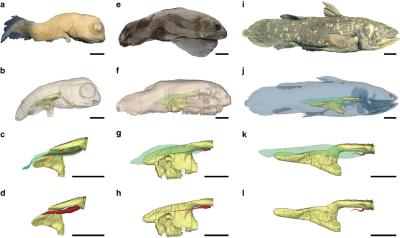- Home
- News
- General News
- The hidden lung...
The hidden lung of the Coelacanth
18-09-2015
An international team of scientists led by Paulo M. Brito and Camila Cupello from Rio de Janeiro State University (Brazil) and in association with the Natural History Museum (France, Paris) has discovered a hidden lung in a living species of the Coelacanth. Through the study of specimens at different stages of embryonic development and a comparison with ancient fossils, the team was also able to reconstruct the evolution of this incredible animal that has inhabited earth for more than 400 million years.
Share
This discovery of the hidden lung was made possible through the use of innovative imaging techniques developed at the ESRF’s ID19 beamline, notably a technique called long propagation phase-contrast synchrotron X-ray microtomography. It is one of the first times that this novel technique has been used on biological samples. The technique was developed at the ESRF during Phase I of the Upgrade Programme – the first phase of a major refurbishment programme which spanned the period 2009-2015. This non-destructive technique enables scientists to characterise materials in 3D and obtain very high quality images, with a sensitivity 1000 times superior than classical techniques of tomography.
Another episode in the incredible story of the coelacanth
The coelacanth is a massive rare order of fish that can measure two metres in length and weigh up to 100 kilos. It is more closely related to lungfish, reptiles and mammals than to the common ray-finned fishes. Until 1938 it was only known in a fossil form and believed to have been extinct since the end of the Cretaceous period. That changed when a South African fisherman caught a specimen almost identical to those displayed in the museums and dating from 70-400 million years old. At the time this event was considered as one of the most significant zoological discoveries of the 20th century. Other specimens with the same prehistoric aspect have since been found in the Mozambique channel and off Sulawesi. The coelacanth has earned itself the title of “living fossil” and continues to fascinate scientists the world over.
In a paper published in Nature Communications the international team of scientists confirmed the presence of a lung in one of the living species of coelacanth and the homology between this lung and the calcified lungs found in fossilised coelacanths, based on the presence of small plates around the lung in the extant species.
The scientists also studied embryos of the specimens at different stages of development and compared their findings to very ancient fossils. They were able to reconstruct the evolution of this incredible animal. They were able to prove, in the adult form of the animal, the existence of a non-functional lung enclosed in a fatty organ that the coelacanth uses to adapt its buoyancy. This organ seems to correspond to the buoyancy function of the liver of sharks, the swim bladder of trout or swordfish, or the wax pouches found in the head cavities of the sperm whale.
From the study of the embryos the scientists discovered that the coelacanth very quickly develops a lung. The lung growth is accelerated in the early stages of life then growth is interrupted and the lung becomes a “vestige” in adult coelacanths, with the fatty organ taking over the growth and enveloping the lung.
The presence of a lung in the coelacanth reveals the incredible capacity of this legendary fish to adapt to its environment and could possibly explain its survival on earth.
Present day coelacanths are deep water fish, living in depths from 120 to 800 metres below the surface of the sea. Fossilised coelacanths were shallow water fish with functional lungs. During the Mesozoic era (250-65 million years ago), the adaptation of some coelacanths to live in deep seas, an environment with very low variations of oxygen pressure, could have triggered the loss of the lung respiration with a marked reduction of the lung and an increase in size of the fatty organ as a buoyancy tool, essential for life in the deep. This could explain how certain species of coelacanths survived the massive extinctions caused by the environmental crises of the Cretaceous (145-66 million years ago) and the Paleogene (65-23 million years ago).
Publication
Cupello, C. et al. Allometric growth in the extant coelacanth lung during ontogenetic development. Nat. Commun. 6:8222 doi:10.1038/ncomms9222 (2015).
Top image: Lateral view of adult specimen. Yellow: oesophagus and stomach; green: fatty organ. Credit: authors




